|
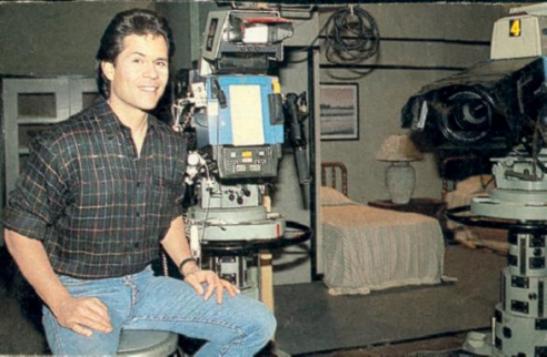 It
is immediately after the Summer Olympics of 1984 that a daytime soap-opera of a
new kind appears on NBC in the United States. Santa Barbara is officially born on screen on Monday, July 30th
1984. It
is immediately after the Summer Olympics of 1984 that a daytime soap-opera of a
new kind appears on NBC in the United States. Santa Barbara is officially born on screen on Monday, July 30th
1984.
1984
Created
by Bridget and Jerome Dobson, the couple of writers at the origin of the program,
the show gets noticed at once by its innovative aspect: a steady rhythm, a light
tone, permanent humor... The writing of the scenarios as the dialogues reach a
level of requirement still never seen in the soap-operas. The storylines are
linked and are ceaselessly renewed, the outdoor shootings are legion, and
numerous comedy scenes clash for this type of program.
From
1984, some main characters immediately mark the televiewers: Mason Capwell, the
black sheep of the family, seems as he just came from a Shakespeare's play;
Augusta Lockridge frightens as much as she fascinates; Santana Andrade
overwhelms by her fragility and her will to find her son... And especially, a
first emblematic couple immediately meets its target: Kelly Capwell and Joe
Perkins, the young heiress and the worker's
son unjustly accused of murder.
But
in spite of very strong storylines, the ratings do not follow. In November 1984,
an earthquake occurs to question a good number of stories and to review the
situation of every character of the show. In the end, few main characters
disappear, but the storylines tighten around both Capwell and Lockridge families
on the four initially present.
1985
At
the beginning of 1985, the storyline of the carnation
killer leads to the disappearance of two very important characters:
Peter Flint and especially Joe Perkins, who had already had to suffer from a
change of interpreter in autumn 1984. Some new "bad guys" make their
entrance (Marcello Armonti, Jack Lee / Jerry Cooper, Kirk Cranston), whereas
others reveal themselves: Gina DeMott takes off, becoming the queen of
machinations and blackmail. 1985 is also the year when the thread-driver
storyline from the first year: Channing Capwell Junior's murder is finally
solved.
In
parallel, a new couple takes over from Kelly and Joe, and this is for the
remainder of the show: Eden Capwell and Cruz Castillo from then on become the
iconic figures of the program, between passionate love, separations and repeated
reunions. Especially, it is the new difference of social status between these
two heroes which creates the attraction of the public: she is a rich fair
Californian girl, he is a modest policeman, son of Mexican immigrants.
The
comedy is always there, but the group of young actors customary of the genre is
dissolved: Danny Andrade, Jade Perkins then Laken Lockridge disappear one after
the other, leaving the young Ted Capwell darker and more grown-up storylines, as
the accusation of rape on Christie DuVall. Some storylines are sometimes too
fast (the Christie DuVall affair, from the rape to the trial, then to the final
outcome, spreads out only over two months), and a large number of characters
appear then disappear, sometimes too fast (Elizabeth Peale, Jackie Parks). So,
at the end of 1985, there is nothing left of the Perkins, and the Andrades are
represented by only two of their original members.
The
year ends in a blaze of glory, with the patriarch C.C. Capwell in a coma, and
Gina's memorable strategy to accuse Eden of having tried to kill him by pulling
the plug of his life support system.
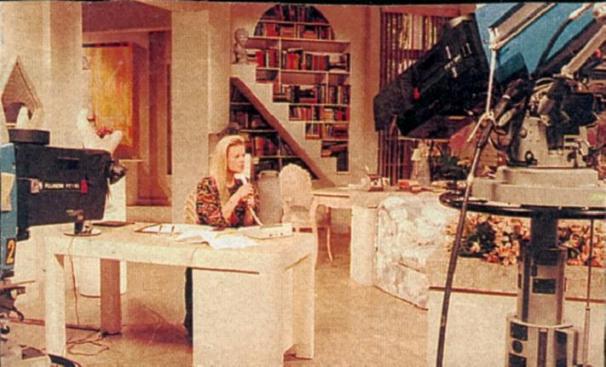 1986 1986
1986
is maybe the year when Santa
Barbara reaches its peak. Many of the best storylines of the show are
gathered this year and delight the fans: the discovery of the real identity of
Brick Wallace, the killing frenzy of Kirk Cranston, the affair of the videotape
acquitting Kelly of Dylan Hartley's death... And especially, two characters
diametrically opposed are going to mark the televiewers forever: the sweet Mary
DuVall, whose unexpected death leaves the fans as orphans, and Keith Timmons,
the shady and eccentric district attorney.
Only
Santa
Barbara can take pride of such a cast, capable of giving life to
characters unthinkable until then in a soap-opera: besides Keith Timmons, Pearl
Bradford, original and slovenly, clashes but immediately takes the sympathy.
Sophia
and C.C. finally form as a real couple, even if Gina watches to make them
separate. The character of Gina continues its ascent, whereas Eden and Cruz, who
have just overcome the last obstacles to their reunion (Kirk and Santana), see
the arrival of a new schemer named Victoria Lane. On the other side, the show
suffers from the departure of Louise Sorel, which sees the Lockridge family
reduced to its chieftain, Lionel.
1987
1987
marks the beginning of a new couple which, in spite of ups and downs, is going
to pursue its development till the end of the show: Julia Wainwright and Mason
Capwell. But the big storyline which is going to stand out this year is the one
surrounding Elena Nikolas, who alternately kidnaps Eden and Mason and makes them
pass as dead, tries to seduce Cruz and commits suicide by accusing him of her
death. Another couple is born, for a more limited duration this time: Kelly and
Jeffrey Conrad. In spite of the importance given to their relationship, it will
never succeed in equaling the couple Kelly and Joe, even after a luxurious
wedding at the end of November.
If
love triangles are legion in the show, one clashes by the links which unite the
characters. Within the triangle Julia, Mason and Victoria, a real relationship
of friendship unites both women and it is together that they suffer from Mason's
absence. 1987 is also the year when the Capwell family takes control of the
storylines. If the Lockridges resist a little, it is only by opposition to their
forever rivals. The departure of the character of Santana Andrade for a while
closes the presence of the other big families in the storylines.
The
storylines go with the flow, always with a great control. But already Santa Barbara loses a
little of its freshness. The writing is more planned, mixing dramatic storylines
closer to what can be expected from a soap-opera (Cruz's
trial, Victoria's addiction to cocaine, Caroline Wilson's disease) with new
developments and scenes of pure comedy. It is because behind the scenes, things
begin to change. Gradually, the Dobsons are pushed towards an exit by New World
Productions which takes control of the show alone. At the head of the production
and the scripts at the end of year is Jill Farren Phelps, who is going to lead Santa Barbara towards a little more classic road, but especially
two years of success.
1988
In
1988, the show suffers from the strike of the American writers, preventing the
new characters from delivering all their potential. It is in particular Pamela
Conrad who pays the price for it. The first big storyline of the year, an affair
of espionage leading Eden and Cruz in Mexico, is short of credibility and seems
too ambitious for a soap-opera. Others that almost fail follow: the manhunt
after Cruz by a mad scientist, Gina indoctrinated by a sect... But the writers
put things right when, on April 1st, they offer to the televiewers the scene
they were waiting for three years: the wedding of Eden and Cruz. Around them,
new characters get in presence on screen: in particular Dr. Scott Clark and
Pamela Conrad, Mason and Jeffrey's
presumed dead mother, who unfortunately disappears after a few months while she
was promised a more long-lasting fate. If new faces arrive (Andrea, the Donnelly
family, Celeste), Santa Barbara loses this
year one of the most likeable characters, Hayley, Gina's
niece.
1988
is also the year when Marcy Walker announces her pregnancy, which makes Eden a
future mom for baby girl Adriana. The show waits for the fall in September to
launch its shocking storyline: the rape of its heroine, Eden Capwell Castillo.
The direction is so realistic and the act is shown in such raw violence that the
fans share their emotion to the direction of NBC. Furthermore, the discovery
that the rapist turns out to be Eden's
gynecologist, Zack Kelton, is only increasing the malaise among the televiewers!
Other themes with rich emotional potential (sometimes particular to the United
States) are tackled, in particular the memory of the Vietnam War and its
traumas, like the discovery of children coming from both cultures for the former
G.I.s.
At
the Daytime Emmy awards in June, Justin Deas wins an award for his performance
as district attorney Keith Timmons, whereas Santa
Barbara is crowned for the first time the best drama of the year.
Finally, the show is recognized by the profession and its quality and its
innovation are publicly rewarded.
But
on the other side of the coin is the departure of Justin Deas and especially of
Robin Wright, replaced in her role by a former playmate who has a great deal of
difficulty in
pulling the wool over the eyes.
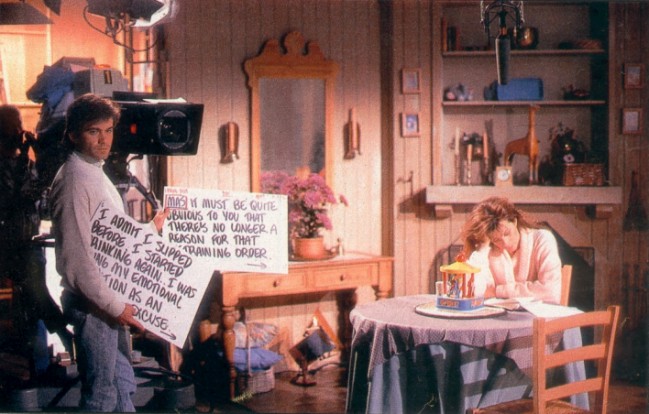 1989 1989
After
Robin Wright, 1989 sees the departure of two other symbolic actors: Lane Davies
(Mason) and Todd McKee (Ted). One is replaced in his role, the other is not. To
boost the always sluggish ratings, numerous new characters make their entrance
within a few weeks: the DiNapoli sisters, the couple Laura and Ethan Asher,
Megan Richardson and her son Greg... But little are going to survive beyond the
year. Around Cruz gets established a family, with his brother Ric and his father
Rafael. It is especially the arrival in June of the character of Robert Barr
which boosts the interest, by creating a new love triangle with Eden and Cruz.
Concerning the eccentricities, if the public lost Keith, it catches with Bunny
Tagliatti, the big-hearted transvestite mafia - a character as only Santa Barbara can invent.
A
part of the team also goes to Paris for the shooting of the episodes of the
kidnapping of Adriana by Cruz's
sister-in-law. These episodes had to be of use as thanking to the French
audience for its loyalty in the show,. In any case, they allow the acquaintance
with the new Kelly, Carrington Garland, who immediately enters the heart of the
televiewers with storylines finally worthy of the character for one year.
Santa
Barbara
pursues its metamorphosis: if the secondary characters change, they darken not
at all the fundamental characters of the show who remain faithful to their
original lines. Only Mason, from now on played by Terry Lester, loses in gravity
to form with Julia a lighter couple, more capable of comedy. The bend concerning
Mason had been in any case widely started with Lane Davies, during the story of
his double personality, Sonny Sprocket, especially treated on a comedy tone.
At the ceremony of the Daytime Emmy awards, Marcy Walker
(Eden), Nancy Grahn (Julia), Justin Gocke (Brandon) and again Justin Deas set
off with a trophy. And Santa
Barbara is again named drama of the year!
1990
In
1990, because of decreasing ratings, Jill Farren Phelps is dismissed and
replaced by John Conboy, who worked among others on the soaps The Young and the Restless
and Capitol.
His first decision is to re-form the Lockridge clan which had completely
disappeared years after years since 1985. Here are thus again Augusta, Lionel
and new Laken and Minx. Other founding acts to leave his print: he rebuilds the
set of the imposing and emblematic Capwell villa, and gradually replaces the
accompanying music which played as landmarks for the televiewers since the
creation of the show. New characters are integrated (Stephen Slade, Derek
Griffin, Amado Gonzalez, the Richards family), but none succeed in really making
an impact. Without doubt the fault is small personalities and the time is not
given to make an impact. Some storylines drag on (the four avenger orphans) and
others are little credible (the kidnapping of Cruz in a Middle East harem). Two
characters are however going to stand out this year: Cassandra Benedict and
Flame Beaufort. Beyond the attraction for their characters, their respective
interpreters have undoubtedly a lot to do with that. The storyline around Quinn
Armitage, who takes the place of his twin brother Robert Barr, boosts the
interest by putting several characters in danger.
One
year after his arrival, Terry Lester leaves the show and is replaced by Gordon
Thomson, more adapted to the role. The comedy scenes also flow with whimsical
characters very well written as Phyllis Blake, Gina's
mother, or Annie DeGeralamo.
The
same year, A Martinez and Henry Darrow (Rafael Castillo) win a Daytime Emmy
award for best actors, respectively for a lead and a supporting role, and Santa Barbara goes out
still victorious of the ceremony as the best show.
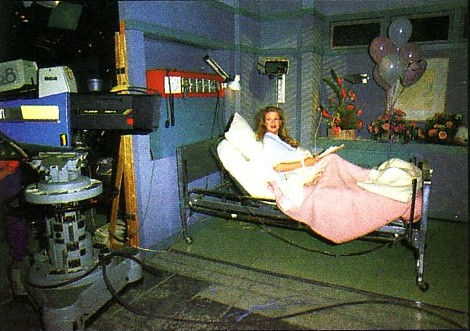 1991 1991
After
a long two years trial with New World Productions, the Dobson couple is
reinstated at the beginning of 1991 as writers. Marcy Walker, after having made
several infidelities to the show to shoot TV movies, announces her intention to
leave definitively in July. To organize the departure of Eden, the character
finds herself in the center of a harrowing and very fascinating storyline of a
split personality, which damages her relationships with her family. The Dobsons
being in control, they bind these disorders with the events on the basis of the
show: Sophia's infidelity and lies, her presumed death and her guilt in the
death of Channing Junior. But the public is disconcerted.
Paul
Rauch is named the new executive producer in June and gradually takes the
Dobsons'
place. Accustomed to soap-operas, he launches into a complete reorganization of
the show. Carrington Garland is dismissed and replaced by Eileen Davidson in the
role of Kelly. The televiewers, who have just lost Eden, have the feeling of
having also lost Kelly. Many new faces come to embody characters who had
disappeared over the years (Ted, Warren, Santana, Lily Blake…), whereas some
new developments seem to come out from nowhere (the past love-affair of
Cassandra and Warren, Kelly finally in love with Quinn and not Robert, Warren
being Lionel's
illegitimate son).
A
new set, a restaurant The Oasis, occupies most of the scenes, which get lost in
endless dialogues to the detriment of the progress of the action.
1992
In
1992, the end of the show is announced for July. At the last moment, six months
as a last chance are given to Pamela K. Long, the new head writer, to try to
raise the bar. It is her who creates the characters of the Walker family towards
whom the main storylines refocus. This is to the detriment of the "historic"
characters, confined for the greater part in lighter storylines or to play
comical stooges (Gina, Lionel…). Julia and Mason, lost in a first storyline of
a haunted house, are going to appear in their turn in the background. Priority
is also given to new young characters, supposed to get the teenagers back in
front of the show. But the frustrated passing
fancy of Lily,
Rafe, Lisa, Sawyer or Aurora do not enthrall much, in particular not the fans
from the very beginning. Only the storyline around the sexual abuse lived by
young B.J. Walker maintains an appearance of interest, whereas the fans cry foul
by seeing Cruz falling in love with his sister-in-law Kelly. The televiewers
have the impression to discover a new show in which would have lost the
characters of the past.
In
front of the in any case inevitable disaster, A Martinez prefers to leave the
ship in July. After his departure, the show knows an ultimate fall of its
ratings, from which it will not get up. After many timetable changes, several
channels affiliated to NBC decide not to broadcast the show any more. The last
episode, centred on the wedding of B.J. and Warren, ends on credits paying
tribute to the technical teams, without a word being said about Eden and Cruz,
the couple which nevertheless carried Santa Barbara during its first seven years.
And
so Santa
Barbara breaks off definitively on Friday, January 15th 1993, after 2137
episodes.
|
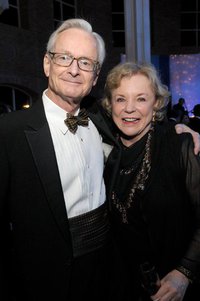 Airing
: July 30 1984
to January 15 1993 on NBC, 2137 episodes (2127
episodes of 43 minutes and 10 episodes of 22 minutes)
Airing
: July 30 1984
to January 15 1993 on NBC, 2137 episodes (2127
episodes of 43 minutes and 10 episodes of 22 minutes)